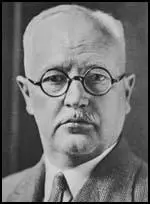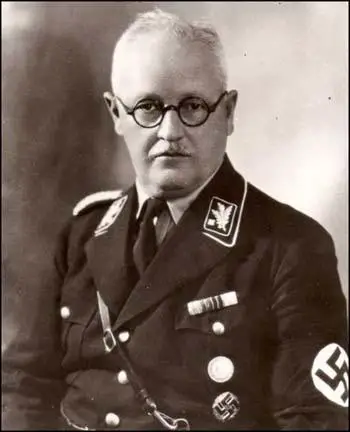Franz Schwarz

Franz Xaver Schwarz, the seventh of eight children born to a master baker and his wife, was born in Günzburg on 27th November 1875. After leaving school he worked for the Günzburger District Court, and then worked as a notary.
Schwarz served in First World War as a second lieutenant in the infantry. Ill-health meant that he was removed from front-line service in 1916. He was considered to be 30 percent by the end of the war, disabled in that war), he was spared field duty beginning in 1916.
After the war Schwarz became an accountant at the Munich City Hall. Schwarz joined the National Socialist German Workers Party (NSDAP) in 1922 and participated in the failed Beer Hall Putsch of November 1923, when Adolf Hitler and many of the senior figures in the party served terms of imprisonment. He become the full-time treasurer of the Nazi Party on 21 March 1925. Hitler has argued: "It's unbelievable what the Party owes to Schwarz. It was thanks to the good order which he kept in our finances that we were able to develop so rapidly."
Alan Bullock, the author of Hitler: A Study in Tyranny (1962), has argued that Schwarz became a member of Hitler's inner-circle, that included Martin Bormann, Emil Maurice, Julius Schaub, Joseph Goebbels, Max Amann, Rudolf Hess, Robert Ley and Heinrich Hoffmann. "After his early days in Munich, Hitler made few, if any, friends... With almost no exceptions, Hitler familiars belonged to the Nazi Old Guard... It was in this intimate circle, talking over the old days, in the Berghof or in his flat in Munich, that Hitler was most at ease."
In April–May 1930 Schwarz negotiated the purchase of the party headquarters, the Brown House in Munich. According to Ernst Hanfstaengel, the author of The Missing Years (1957), Schwarz was responsible for paying off blackmailers who had evidence of Hitler's sexual perversions. Hanfstaengel says that one day in 1930 Schwarz told him that he had to buy off someone who was trying to blackmail Hitler over some drawings of Geli Raubal. "The man had somehow come into the possession of a folio of pornographic drawings. Hitler had made... They were depraved intimate sketches of Geli Raubal, with every anatomical detail."
On the morning of Saturday, 19th September, 1931, Geli Raubal's body was found on the floor of her room in the flat. A meeting was held by leading officials, including Franz Schwarz, Gregor Strasser, Baldur von Schirach, Max Amann and Rudolf Hess. They discussed what they should do before the police were brought to Hitler's apartment. Ronald Hayman, the author of Hitler & Geli (1997) has pointed out: "We know that a top-level conference of Munich Nazis was held in his flat during the morning of Saturday, 19 September, though we do not know what time it began or who convened it.... Eventually Schirach telephoned Adolf Dresler of the press department at the Brown House, instructing him to tell the press that Hitler had gone into deep mourning after his niece's suicide. But they went on arguing about whether this was the best line to take, and they decided it was not. Schirach made another call to Dresler, telling him to say it had been an accident."
As Ron Rosenbaum, the author of Explaining Hitler: The Search for the Origins of his Evil (1998) has explained: "Franz Xaver Schwarz, the party treasurer and one of the closest confidants of Hitler among the old comrades from the party's 'struggle period' in the twenties. Schwarz had apparently been summoned to the death scene even before the police that morning. Schwarz made clear to Detective Sauer that Hitler had been far away from his apartment when his niece had taken Hitler's gun and shot herself." Eventually, the police were called and Detective Sauer arrived and interviewed the witnesses. Schwarz insisted that Hitler had not been in the apartment at the time of Geli's death. However, he did discover that the Walther 6.35 pistol that killed Geli was owned by Hitler.
Schwarz was elected to the Reichstag in 1933, representing the Franconia electoral district. In June 1933 Schwarz joined the Schutzstaffel (SS). On 1 July 1933 he was appointed SS-Obergruppenführer. Later, he was one of only four people to have held the rank of SS-Oberst-Gruppenführer.
James Pool, the author of Who Financed Hitler: The Secret Funding of Hitler's Rise to Power (1979) has pointed out that Schwarz was a very important figure in the Nazi Party: "The exact details of all the Nazi Party's business and financial affairs were worked out under the direction of Party treasurer Schwarz... He had started to work for the Nazis in 1924... Coming to see Hitler in Landsberg prison, the fat, bald, bespectacled Schwarz said that he was fed up with working for the petty individuals who controlled the Popular Block and would be pleased to work for the Nazis for a change."

On 23 March 1934, Adolf Hitler gave Schwarz full authority for the financial affairs of the party. He was also named a Reichsleiter (Reich Leader), which was the second highest political rank of the Nazi Party. Hitler commented: "I was not slow to perceive his qualities.... Schwarz organized, in a model fashion, everything that gradually became the Party's gigantic financial administration.... He had the fault - and what luck that was! - of not being a lawyer and nobody had more practical good sense than he had. He knew admirably how to economize on small things - with the result that we always had what we needed for important matters. It was Schwarz who enabled me to administer the Party without our having to rely on petty cash. In this way, unexpected assets are like manna." Joseph Goebbels was also impressed with Schwarz who he regarded as an able administrator.
During the Second World War Schwarz was granted the military award, the War Merit Cross, for his work during the Munich air raids of 24th and 25th April of 1942. Schwarz continued to control the finances of the Nazi Party. According to James Pool: "All the data concerning the sources of the Nazis' Party income was assembled in Schwarz's office. Every pfennig was booked as to its origin with meticulous care. Treasurer Schwarz's accounts have never been found. This is one of the greatest mysteries surrounding the last days of the Nazi regime. Hitler trusted Schwarz completely and consequently told him the source of even 'anonymous' contributions, so the name of the donor could be recorded and he could be approached again in the future. Which industrialists contributed to Hitler before 1933? Precisely how much did they give? These questions would undoubtedly have been answered in detail by the books of the Party treasurer, just as the Party membership records which were also kept in the Brown House revealed every individual who belonged to the Party."
Franz Xaver Schwarz, who was arrested after the war, died in an Allied internment camp near Regensburg on 2nd December 1947. In September 1948, Schwarz was posthumously classified by the Munich de-Nazification court as a "major offender".
Primary Sources
(1) James Pool, Who Financed Hitler: The Secret Funding of Hitler's Rise to Power (1979)
The exact details of all the Nazi Party's business and financial affairs were worked out under the direction of Party treasurer Schwarz... He had started to work for the Nazis in 1924... Coming to see Hitler in Landsberg prison, the fat, bald, bespectacled Schwarz said that he was fed up with working for the petty individuals who controlled the Popular Block and would be pleased to work for the Nazis for a change....
All the data concerning the sources of the Nazis' Party income was assembled in Schwarz's office. Every pfennig was booked as to its origin with meticulous care. Treasurer Schwarz's accounts have never been found. This is one of the greatest mysteries surrounding the last days of the Nazi regime. Hitler trusted Schwarz completely and consequently told him the source of even 'anonymous' contributions, so the name of the donor could be recorded and he could be approached again in the future. Which industrialists contributed to Hitler before 1933? Precisely how much did they give? These questions would undoubtedly have been answered in detail by the books of the Party treasurer, just as the Party membership records which were also kept in the Brown House revealed every individual who belonged to the Party.
(2) Ronald Hayman, Hitler & Geli (1997)
We know that a top-level conference of Munich Nazis was held in his flat during the morning of Saturday, 19 September, though we do not know what time it began or who convened it. Gregor Strasser, Rudolf Hess, Max Amann, Franz Schwarz and Baldur von Schirach discussed what should be done. Eventually Schirach telephoned Adolf Dresler of the press department at the Brown House, instructing him to tell the press that Hitler had gone into deep mourning after his niece's suicide. But they went on arguing about whether this was the best line to take, and they decided it was not. Schirach made another call to Dresler, telling him to say it had been an accident.
(3) Ron Rosenbaum, Explaining Hitler: The Search for the Origins of his Evil (1998)
Franz Xaver Schwarz, the party treasurer and one of the closest confidants of Hitler among the old comrades from the party's 'struggle period' in the twenties. Schwarz had apparently been summoned to the death scene even before the police that morning. Schwarz made clear to Detective Sauer that Hitler had been far away from his apartment when his niece had taken Hitler's gun and shot herself.
